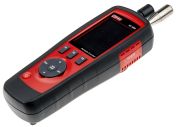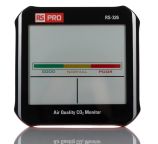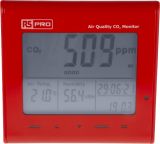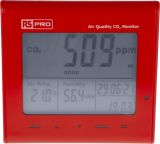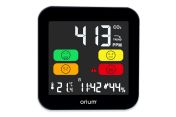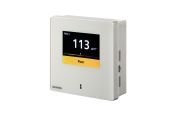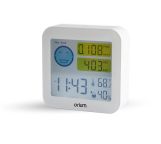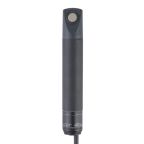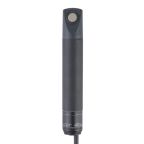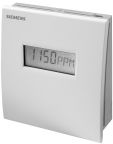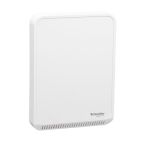- Automation & Control Gear
- Cables & Wires
- Enclosures & Server Racks
- Fuses & Circuit Breakers
- HVAC, Fans & Thermal Management
- Lighting
- Relays & Signal Conditioning
- Switches
- Batteries & Chargers
- Connectors
- Displays & Optoelectronics
- ESD Control, Cleanroom & PCB Prototyping
- Passive Components
- Power Supplies & Transformers
- Raspberry Pi, Arduino, ROCK, STEM Education & Development Tools
- Semiconductors
Air Quality Monitors
Whether you are working in a laboratory, factory, or office, or simply want to ensure that your home is pollutant-free, air quality monitors are a vital tool for measuring and maintaining healthy air conditions.
Air quality monitors (also known as pollution monitors) are devices that are used to accurately check the quality of indoor and outdoor air by detecting harmful gases, particulate matter, and environmental parameters. Many monitors provide real-time alerts when air quality reaches unsafe levels.
Advanced air quality testing devices can log data for trend analysis and transfer measurements to computers or cloud platforms for comprehensive reporting. By checking air quality, you can ensure that dangerous levels of pollutants are detected quickly, minimising the negative health effects of air pollution.
What Do Air Quality Monitors Measure?
Air quality monitors identify and quantify various airborne substances using specific sensor configurations. Key analytes include:
- Particulate Matter (PM): Fine (PM2.5) and coarse (PM10) particles from industrial processes, combustion, and construction.
- Volatile Organic Compounds (VOCs): Carbon-based chemicals like solvents and industrial by-products (e.g., formaldehyde, benzene).
- Gaseous Pollutants:
- Carbon Dioxide (CO2): Indicator of ventilation adequacy.
- Carbon Monoxide (CO): Toxic gas from incomplete combustion.
- Nitrogen Dioxide (NO2): Emitted from high-temperature combustion sources.
- Sulphur Dioxide (SO2): From fossil fuel combustion and industrial processes.
- Ozone (O3): Secondary pollutant relevant for outdoor and specific indoor applications.
- Other Gases: Ammonia (NH3), hydrogen sulphide (H2S), chlorine (Cl2), as per application needs.
- Environmental Parameters: Temperature and relative humidity, often measured alongside pollutants to provide context for air quality.
Where Are Air Quality Monitors Used?
AQMs are deployed across numerous industrial and commercial sectors for safety, compliance, and operational efficiency:
- Manufacturing & Chemical Plants: Monitoring solvent vapours, particulates, and toxic gases to protect workers and ensure compliance.
- Construction & Mining: Assessing dust (silica, coal) and hazardous gases like methane (CH4) and carbon monoxide (CO).
- Oil & Gas Facilities: Detecting hydrocarbon leaks, H2S, and VOCs for safety.
- Pharmaceutical Cleanrooms: Ensuring ultra-low particulate and microbial levels to meet GMP standards.
- Wastewater Treatment: Monitoring H2S and NH3.
- Commercial Buildings: Optimising HVAC systems based on CO2 and VOC levels.
- Environmental Agencies: Ambient air quality monitoring for regulatory purposes.
Types of AQMs
AQMs are categorised by their deployment strategy, sensor configuration, and application focus:
Fixed Air Quality Monitors
Designed for continuous, long-term monitoring at a static location, often integrated into facility control systems. They typically require mains power and offer advanced data logging and communication.
Portable Air Quality Monitors
Compact, battery-operated units for spot-checking, personal exposure monitoring, and site surveys, offering flexibility and immediate data retrieval.
Single-Gas and Multi-Gas Monitors
Single-gas units target one specific contaminant, while multi-gas monitors incorporate several sensors to detect multiple substances simultaneously, common in complex environments or confined space entry.
Particulate Monitors
Specialised devices, often using optical methods, for real-time measurement of airborne particle concentrations (e.g., PM2.5, PM10).
How Do Air Quality Monitors Work?
Air quality monitors function by drawing an air sample across or into air quality sensors designed to react to specific pollutants, converting their concentration into an electrical signal.
Key sensor technologies include:
- Electrochemical sensors for toxic gases like CO, H2S, and NO2, where gas reacts with an electrolyte to produce a current proportional to its concentration.
- Optical sensors (photometers) for particulate matter (PM2.5, PM10), measuring light scattered by particles passing through a light beam.
- Metal-Oxide Semiconductor (MOS) sensors for various VOCs and combustible gases, detecting changes in electrical resistance upon gas adsorption.
- Non-Dispersive Infrared (NDIR) sensors for CO2, measuring infrared light absorption at specific wavelengths.
- Photoionisation Detectors (PIDs) for low concentrations of VOCs, using UV light to ionise gas molecules and measure the resulting current.
These electrical signals are processed by internal microcontrollers, which apply calibration factors and convert the data into concentration units (e.g., ppm, μg/m3) displayed in real-time. Advanced models incorporate data logging, alarm functions, and connectivity modules (Wi-Fi, Bluetooth) for remote monitoring and integration with building management or industrial control systems.
Indoor vs. Outdoor Air Quality Monitors
Indoor and outdoor AQMs differ significantly in design, sensor suites, power, and typical applications to suit their operational environments.
Design Considerations
Indoor air quality monitors are generally compact and designed for less harsh environments. Outdoor models feature rugged, weather-resistant (IP-rated) enclosures to withstand environmental extremes.
Sensor Capabilities
Indoor units typically focus on IAQ parameters like CO2, VOCs, and PM2.5. Outdoor monitors often measure a wider range of ambient pollutants, including O3, NO2, and SO2, aligning with environmental standards.
Power Supply Options
Indoor air quality detectors often use standard AC power or batteries. Outdoor units may rely on solar power, battery systems, or direct industrial power connections for continuous operation.
Primary Use Cases
Indoor AQMs aim to optimise occupant health, comfort, and HVAC efficiency. Outdoor AQMs are primarily for regulatory environmental monitoring, tracking industrial emissions, and public health information.
Key Features to Look for in an Air Quality Monitor
Selection of an industrial AQM necessitates evaluation of critical technical features:
Pollutant Detection Capability
Ensure the monitor accurately detects target pollutants within the required concentration ranges. Verify sensor type, sensitivity, selectivity, and accuracy. Consider calibration frequency and procedure.
Data Acquisition, Display, and Alarms
Look for clear real-time displays, robust data logging capacity (interval, storage, retrieval), and effective alarm systems (visual, audible, adjustable setpoints) for immediate hazard notification.
Connectivity and System Integration
Assess connectivity options (Wi-Fi, Ethernet, Modbus, BACnet) for remote monitoring, data transmission to cloud platforms, and integration with existing SCADA, BMS, or industrial control systems. Consider power options and IP rating for environmental suitability.
Industrial Applications of Air Quality Monitors
AQMs provide critical data for safety, compliance, and efficiency across various industrial sectors.
- Manufacturing Environments: Monitors track VOCs from solvents and paints, airborne particulates from machining, and combustion gases (CO, NOx) to protect workers and product quality.
- Mining and Construction Sectors: Essential for measuring dust levels (silica, coal) and toxic/explosive gases (CH4, CO, H2S) in harsh and confined conditions to ensure worker safety and adequate ventilation.
- Pharmaceutical and Cleanroom Facilities: Particle counters and microbial air samplers ensure adherence to stringent cleanliness standards (e.g., ISO 14644-1) for product integrity and GMP compliance.
- Food and Beverage Processing: Air quality detectors monitor for airborne microbes, dust, and specific gases (e.g., NH3 from refrigeration, O3 from sanitisation) to prevent contamination and ensure food safety. Control of humidity and temperature is also often integrated.
The Leading Supplier and Distributor of Air Quality Monitors in Malaysia
RS stands as your trusted partner for high-performance air quality monitors in Malaysia. We offer a comprehensive portfolio from renowned manufacturers such as Testo, Siemens, and Extech. Our inventory features diverse models, including portable and fixed units, single-gas and multi-gas detectors, and particulate counters, all competitively priced to ensure you secure the ideal air quality monitoring solution for your specific industrial requirements.
To complement your air quality management strategy, we also supply essential instrumentation and accessories to support your systems. Our catalogue includes items like smoke detector testers, pressure sensors, and insulation testers—all vital for ensuring precise calibration, diagnostics, and ongoing maintenance. Get these products and more through our online store today. For detailed information regarding our ordering procedures, delivery options, and associated fees, please visit our dedicated delivery page.
Popular Searches
Related links
- Extech AC Adapter for Use with IAQ320 Indoor Air Quality Monitor and Datalogger
- Seeed Studio Grove-VOC and eCO2 Gas Sensor (SGP30) Gas Sensor for SGP30 Indoor Air Quality Application
- ifm electronic SL0201 Air Quality Monitor for Air Velocity, +50°C Max
- RS PRO DT-802 Air Quality Monitor for CO2 Temperature 90%RH Max, Mains-Powered
- ifm electronic SLG23CEEAKOA/PH Air Quality Monitor for Air Velocity 90%RH Max
- Digitron AM60 Data Logging Air Quality Monitor for CO2 Temperature 95%RH Max, Battery-Powered
- Siemens LoRa Indoor Air Quality Multi Sensor
- Seeed Studio Grove-Temperature Pressure and Gas Sensor (BME680) for BME680 Indoor Air Quality Application,
